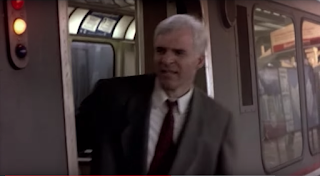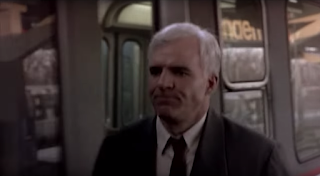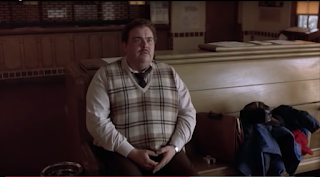Steve Martin and John Candy are best known as comedic performers, but in Planes, Trains & Automobiles, writer/director John Hughes allows them to display their dramatic range. That's especially true in this poignant scene near the end.
After all their crazy adventures and unexpected bonding, Neal (Martin) and Del (Candy) have reached Chicago and are going their separate ways. Neal, who has learned to lighten up, sits on the train ride home as he reflects on the journey he's been on. The scene intercuts from closeups of Martin's face with previous scenes in the movie, and we see a good deal of emotion: amusement, humor, embarrassment at his earlier stuckup behavior, etc.
We've seen how Neal has changed for better, and the movie feels like it's wrapping up, but then Neil remembers an earlier comment by Del. In a bar, Neil remarked how he had been spending too much time away from home, to which Del replied, "I haven't been home in years."
As Del's words echo and fade, Neal considers them. In this closeup, we can see Neal's face as he goes from reminiscing to confusion and concern. We can see part of the train car in the background, so we still know where Neal is, but the shot has a shallow focal depth. The background is kind of blurry. The emphasis is on Neal and what he's thinking.
High Angle Establishing Shot. A train pulls into the station Neil previously left. It's a quick shot that lets us know Neal has returned, and it keeps the momentum of the scene fast. Neal is on to something.
A medium tracking shot pans left to follow Neal off the train as he races back to the station. We still get a decent look at Neal's increasing concern on his face, but now, the unsteadiness of the shot and its movement with him reflect his urgency. Neal moves so fast, he walks right out of the frame.
A wide shot of Neal entering the station.
A reverse wide shot of Del sitting at a bench. A few of details to note.
One: he's taken off his coat, so he clearly was planning on staying there a while.
Two: there's no one else. The empty space between the benches illustrates how alone Del is.
Three: Del looks small. His whole body is in frame. He looks so helpless.
A close, somewhat low-angle shot of Neal. Steve Martin was obviously more slender than John Candy, but in this shot, he fills the frame. We only see him from the chest up. He looks in control and dominant. We're looking up at him. This shot downplays the size difference between the two men.
"Del, what are you doing here?" Neal asks.
A medium, slightly high angle shot of Del as Neal crosses the room to face him. Though not as much as his previous shot, Del still looks comparatively small. We're looking down at him, and he looks vulnerable. His hands are folded in his lap, nervous like.
Neal, meanwhile, strides through the frame, but we can't even see his head, which makes him appear larger.
"You said you were going home. What are you doing here?" Neal asks.
A medium, low angle shot of Neal looking down at Del. The camera has pulled back from him some, but he still dominates the frame. The empty space next to him creates an expectant feeling; we, too are waiting for what Dell has to say.
"I, uh," Dell stammers.
Closeup. Del's face is tilted, off balanced compared to the rest of the frame, which is out of focus. We can see how pained, lonely, and fragile he is.
"I don't have a home," he continues.
Closeup on Neal. The background is fuzzy, so we can focus on his shock. The camera is lined up with his face, so he doesn't loom over us as he did in earlier shots. He's more level with us.
Back to the closeup of Del.
"Marie's been dead for eight years." Marie, of course, is the wife Dell has spent the whole gushing about, his love for her so transparent and strong. To find out she's been all this time feels like someone just slapped us.
Another closeup of Neal, this one longer than the others. We see as he works through several different emotions: sadness, understanding, sympathy, maybe a touch of shame (for some of the things he said to Del earlier). He like, us, is processing what he just heard, but there's a shift. By the end of the shot, he looks up with a curious look in his eye.
This is our valedictory shot: a wide shot of these two men, walking side by side, helping each other carry the luggage to Neal's house. Closeups can be a bit claustrophobic if they can go on too long or there are too many of them, so the open space around them is a relief (especially given the cramped accommodations they've put up with all movie).
We saw empty space around Del earlier, but now, he and Neal are together. These two mismatched men have bonded and become friends. They're sharing space willingly, and the shot is visually balanced.
We've seen how Neal has changed for better, and the movie feels like it's wrapping up, but then Neil remembers an earlier comment by Del. In a bar, Neil remarked how he had been spending too much time away from home, to which Del replied, "I haven't been home in years."
As Del's words echo and fade, Neal considers them. In this closeup, we can see Neal's face as he goes from reminiscing to confusion and concern. We can see part of the train car in the background, so we still know where Neal is, but the shot has a shallow focal depth. The background is kind of blurry. The emphasis is on Neal and what he's thinking.
High Angle Establishing Shot. A train pulls into the station Neil previously left. It's a quick shot that lets us know Neal has returned, and it keeps the momentum of the scene fast. Neal is on to something.
A medium tracking shot pans left to follow Neal off the train as he races back to the station. We still get a decent look at Neal's increasing concern on his face, but now, the unsteadiness of the shot and its movement with him reflect his urgency. Neal moves so fast, he walks right out of the frame.
A wide shot of Neal entering the station.
A reverse wide shot of Del sitting at a bench. A few of details to note.
One: he's taken off his coat, so he clearly was planning on staying there a while.
Two: there's no one else. The empty space between the benches illustrates how alone Del is.
Three: Del looks small. His whole body is in frame. He looks so helpless.
A close, somewhat low-angle shot of Neal. Steve Martin was obviously more slender than John Candy, but in this shot, he fills the frame. We only see him from the chest up. He looks in control and dominant. We're looking up at him. This shot downplays the size difference between the two men.
"Del, what are you doing here?" Neal asks.
A medium, slightly high angle shot of Del as Neal crosses the room to face him. Though not as much as his previous shot, Del still looks comparatively small. We're looking down at him, and he looks vulnerable. His hands are folded in his lap, nervous like.
Neal, meanwhile, strides through the frame, but we can't even see his head, which makes him appear larger.
"You said you were going home. What are you doing here?" Neal asks.
A medium, low angle shot of Neal looking down at Del. The camera has pulled back from him some, but he still dominates the frame. The empty space next to him creates an expectant feeling; we, too are waiting for what Dell has to say.
"I, uh," Dell stammers.
Closeup. Del's face is tilted, off balanced compared to the rest of the frame, which is out of focus. We can see how pained, lonely, and fragile he is.
"I don't have a home," he continues.
Closeup on Neal. The background is fuzzy, so we can focus on his shock. The camera is lined up with his face, so he doesn't loom over us as he did in earlier shots. He's more level with us.
Back to the closeup of Del.
"Marie's been dead for eight years." Marie, of course, is the wife Dell has spent the whole gushing about, his love for her so transparent and strong. To find out she's been all this time feels like someone just slapped us.
Another closeup of Neal, this one longer than the others. We see as he works through several different emotions: sadness, understanding, sympathy, maybe a touch of shame (for some of the things he said to Del earlier). He like, us, is processing what he just heard, but there's a shift. By the end of the shot, he looks up with a curious look in his eye.
This is our valedictory shot: a wide shot of these two men, walking side by side, helping each other carry the luggage to Neal's house. Closeups can be a bit claustrophobic if they can go on too long or there are too many of them, so the open space around them is a relief (especially given the cramped accommodations they've put up with all movie).
We saw empty space around Del earlier, but now, he and Neal are together. These two mismatched men have bonded and become friends. They're sharing space willingly, and the shot is visually balanced.
Also, we never witnessed Neal verbally invite Dell home with him. He must have, but we don't need to see it. This silent shot is all we needed to convey that.
This sequence shows the power of the closeup. When you move the camera that close to someone's face, you emphasize two things: their emotions and their words. We see how vulnerable Del really is. We see the change of Neal from the start of a movie as a selfish workaholic to a concerned friend.
There's little dialogue here, ironic considering that was always a strength of John Hughes as a writer, but good dialogue doesn't just mean memorable quotes from start to finish. It also means knowing when to leave things unsaid. Del has been a rambling motormouth all movie; to see him reduced to short, direct sentences hits you.
Meanwhile, when Neal learns the truth, the movie wordlessly cuts from the men in the station to them walking together to Neal's house. No hesitation. No pontificating. Of course Neal is going to bring this gentle, lonely man home for Thanksgiving. It's a powerful, visual statement.
This sequence shows the power of the closeup. When you move the camera that close to someone's face, you emphasize two things: their emotions and their words. We see how vulnerable Del really is. We see the change of Neal from the start of a movie as a selfish workaholic to a concerned friend.
There's little dialogue here, ironic considering that was always a strength of John Hughes as a writer, but good dialogue doesn't just mean memorable quotes from start to finish. It also means knowing when to leave things unsaid. Del has been a rambling motormouth all movie; to see him reduced to short, direct sentences hits you.
Meanwhile, when Neal learns the truth, the movie wordlessly cuts from the men in the station to them walking together to Neal's house. No hesitation. No pontificating. Of course Neal is going to bring this gentle, lonely man home for Thanksgiving. It's a powerful, visual statement.





















No comments:
Post a Comment